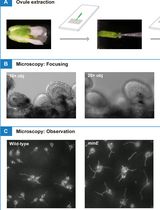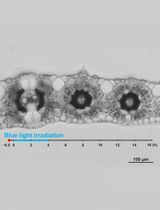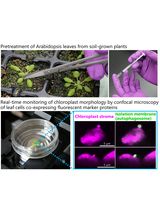- EN - English
- CN - 中文
Colocalization Assay with Fluorescent-tagged ATG8 Using a Nicotiana benthamiana-based Transient System
本氏烟草的瞬态系统进行荧光标记 ATG8 的共定位分析
发布: 2022年08月20日第12卷第16期 DOI: 10.21769/BioProtoc.4486 浏览次数: 3356
评审: Wenrong HeYuan WangYe XuAnonymous reviewer(s)
Abstract
Autophagy is an evolutionarily conserved intracellular degradation process. During autophagy, a set of autophagy-related (ATG) proteins orchestrate the formation of double-bound membrane vesicles called autophagosomes to engulf cytoplasmic material and deliver it to the vacuole for breakdown. Among ATG proteins, the ATG8 is the only one decorating mature autophagosomes and therefore is regarded as a bona fide autophagic marker; colocalization assays with ATG8 are wildly used as a reliable method to identify the components of autophagy machinery or autophagic substrates. Here, we describe a colocalization assay with fluorescent-tagged ATG8 using a tobacco (Nicotiana benthamiana)-based transient expression system.
Keywords: Autophagy (自噬)Background
As a highly conserved catabolic process, autophagy is sophisticatedly employed by eukaryotic cells to remove dysfunctional proteins and unwanted or damaged organelles via the vacuole in yeast and plants or the lysosome in animals. During autophagy, a set of ATG proteins, commonly referred to as core autophagic machinery, are recruited to direct the formation of autophagosomes (Marshall and Vierstra, 2018). Among them, ubiquitin-like protein ATG8 (or its mammalian homolog, LC3) is first lipidated through a ubiquitination-like enzymatic cascade and then coats expanding autophagic vesicles to promote the maturation of autophagosomes. Moreover, the lipidated ATG8 on the inner membrane of autophagosomes can serve as a docking platform for autophagy receptors to recruit specific cargoes during selective autophagy. When autophagosomes fuse with the vacuole or lysosome, the lipidated ATG8 lining the outer membrane is released by ATG4 and recycled, whereas the lipidated ATG8 on the inner membrane is degraded together with cargoes into the vacuole. Therefore, ATG8 is regarded as a bona fide marker for autophagosomes, and colocalization assays with ATG8 are wildly used as a reliable method for identification of ATG components or autophagic cargoes (Marshall and Vierstra, 2018).
Colocalization assays with fluorescent-tagged ATG8 have been carried out stably with transgenic plants or transiently with a protoplast expression system (Suttangkakul et al., 2011; Zhuang et al., 2013). Here, we have developed an alternative colocalization assay based on a tobacco (Nicotiana benthamiana) transient expression system. With this system, we have successfully detected the colocalization between ATG8 and multiple proteins of interest (POIs; Luo et al., 2021).
This protocol includes four major steps: 1) Vector construction; 2) Agrobacterium-mediated transient expression; 3) Concanamycin A (ConA) infiltration; 4) Confocal fluorescence microscopy imaging.
Materials and Reagents
1.5 mL microcentrifuge tubes (Biosharp, catalog number: BS-15-M)
50 mL mini bioreactor tubes (NEST, catalog number: 602052)
9 cm Petri dish (Sangon Biotech, catalog number: F611001)
1 mL syringe
Microscope slides, 76 × 26 mm (Sangon Biotech, catalog number: F518101)
Cover slides, 24 × 60 mm (Sangon Biotech, catalog number: F518118)
Marker pen
Single-edge razor blade
Aluminum foil
4-week-old Nicotiana benthamiana seedlings
7-day-old Arabidopsis seedlings
Agrobacterium tumefaciens strain GV3101
E. coli DH5α competent cells (Home-made)
LB (Sangon Biotech, catalog number: A507002)
Sucrose (Sangon Biotech, catalog number: A610498)
MgSO4 (Sangon Biotech, catalog number: A601988)
Agar (Sangon Biotech, catalog number: A505255)
MES (Sangon Biotech, catalog number: A610341)
0.5 M EDTA solution, pH 8.0 (Sangon Biotech, catalog number: B540625)
Acetosyringone (Sangon Biotech, catalog number: A601111)
Dimethyl sulfoxide (DMSO) (Sangon Biotech, catalog number: A100231)
MS basal salt mixture (Caisson, catalog number: 05210003)
Concanamycin A (Adipogen, catalog number: BVT-0237-C100)
Plant RNAout kit (Tiandz Inc., catalog number: 160906-50)
HiScript® II Q RT SuperMix for qPCR Kit (Vazyme Biotech Co., Ltd, catalog number: R222-01)
HiPure Gel DNA Mini Kit (Magen, catalog number: D2111-03)
ClonExpress® II One-Step Cloning Kit (Vazyme Biotech Co., Ltd, catalog number: C112-01)
pEGAD vector (NCBI accession No. AF218816)
FastDigest EcoRI-HF (NEB, catalog number: R3101M)
FastDigest BamHI-HF (NEB, catalog number: R3136M)
Antibiotics (All purchased from Sangon Biotech; Kanamycin sulfate, catalog number: A506636 Rifampicin, catalog number: A600812; Gentamycin sulfate, catalog number: A506614)
Liquid nitrogen
Bacterial suspension buffer (see Recipes)
ConA stock solution (0.5 mM) (see Recipes)
MS-C liquid medium (see Recipes)
Equipment
Centrifuge (Eppendorf, model: 5804 R)
Water bath
Eppendorf Research® plus Pipette (0.5–10 μL pipette, catalog number: 3120000020; 10–100 μL pipette, catalog number: 3120000046; 100–1,000 μL pipette, catalog number: 3120000062)
Nanodrop spectrophotometer (NanoDrop, model: ND-1000)
Incubator
Flow hood
Plant growth chamber (Ningbo Jiangnan Instrument Factory, model: RXZ-500C)
pH meter (Sartorius, model: PB-10)
Thermocycler (Bio-Rad, model: S1000)
Autoclave (HIRAYAMA, model: HVE-50)
Vortexer (Kylin-Bell, model: VORTEX-5)
Procedure
文章信息
版权信息
© 2022 The Authors; exclusive licensee Bio-protocol LLC.
如何引用
Mai, J., Shang, D., Li, F. and Luo, N. (2022). Colocalization Assay with Fluorescent-tagged ATG8 Using a Nicotiana benthamiana-based Transient System. Bio-protocol 12(16): e4486. DOI: 10.21769/BioProtoc.4486.
分类
植物科学 > 植物细胞生物学 > 细胞成像
细胞生物学 > 细胞成像 > 荧光
分子生物学 > 蛋白质 > 蛋白质-蛋白质相互作用
您对这篇实验方法有问题吗?
在此处发布您的问题,我们将邀请本文作者来回答。同时,我们会将您的问题发布到Bio-protocol Exchange,以便寻求社区成员的帮助。
Share
Bluesky
X
Copy link












